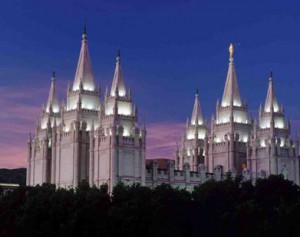 When God delivered the ancient Israelites from their captivity in Egypt, He commenced the hard work of making of them a nation of priests, a holy nation. Almost immediately, He commanded them to build a “tabernacle,” a portable temple that would be the House of God. This would be a place dedicated and holy where God’s presence could dwell, essentially a conduit between heaven and earth. All religious worship centered on the temple. It was not only a place of worship, but a training center to teach the fundamentals of the doctrines of sacrifice, obedience, and repentance.
When God delivered the ancient Israelites from their captivity in Egypt, He commenced the hard work of making of them a nation of priests, a holy nation. Almost immediately, He commanded them to build a “tabernacle,” a portable temple that would be the House of God. This would be a place dedicated and holy where God’s presence could dwell, essentially a conduit between heaven and earth. All religious worship centered on the temple. It was not only a place of worship, but a training center to teach the fundamentals of the doctrines of sacrifice, obedience, and repentance.
As the Tabernacle was a hallowed place, so were the later constructed temples of Solomon, Zerrubabel and Herod. Christ was born after the reconstruction of the latter. When Jesus was thirty days old, Joseph and Mary brought their son to the temple, in accordance with the Law of Moses. At the age of twelve, Jesus and his parents returned to Jerusalem for the feast of the Passover, an annual tradition in his family (Luke 2:41-42 KJV). Jesus Christ knew as a boy where to go to speak of holy things, and his parents found Him teaching the elders in the temple. His later cleansing of the temple shows that Jesus upheld its sacred nature, even as Jewish leaders were corrupting the Law of Moses and ignoring the identity of Jesus Christ as the true Messiah.
Temples, therefore, must play a role in Christian worship. This urges other important questions, such as who has the authority to build a temple, how should it be built, and what happens inside once it’s built? David and Solomon were given specific charges by God to build the temple or perform temple building related tasks. Clearly, one just can’t just build a temple and stamp Gods’ seal of approval on it without being given the authority to do so. Yet the scriptures are plain on the necessity of modern temples. Isaiah said,
And it shall come to pass in the last days, that the mountain of the Lord’s house shall be established in the top of the mountains, and shall be exalted above all the hills; and all nations shall flow unto it.
And many people shall go and say, Come ye, and let us go up to the mountain of the Lord, to the house of the God of Jacob; and he will teach us of his ways, and we will walk in his paths, for out of Zion shall go forth the law, and the word of the Lord from Jerusalem (Isaiah 2: 2, 3).
 This scripture is referring to the time just prior to the return of the resurrected Jesus Christ. It is clear that if the symbol of a mountain is referring to a temple, then there must be a restoration of temple worship in modern Christianity before Christ comes again.
This scripture is referring to the time just prior to the return of the resurrected Jesus Christ. It is clear that if the symbol of a mountain is referring to a temple, then there must be a restoration of temple worship in modern Christianity before Christ comes again.
To draw connections between ancient temples and modern Mormon temples, in order to go forward, one must first go back. Let us therefore step back into the time predating Herod or Solomon’s temple-back to the days of the portable Tabernacle. To more fully understand temples, and why a restoration of temples might be necessary, it is important to know what the Tabernacle was like and what happened inside of it.
Next – The Tabernacle
